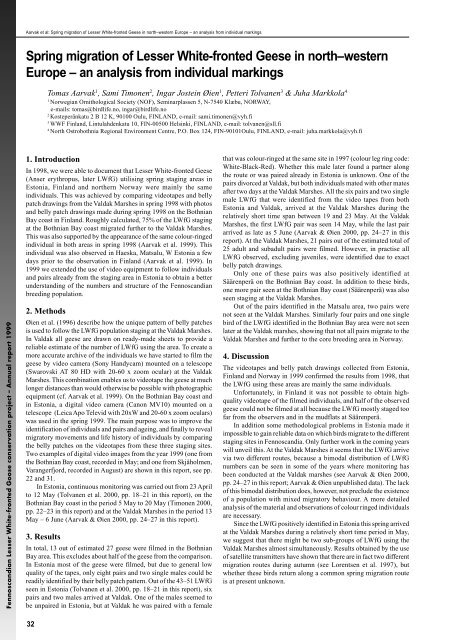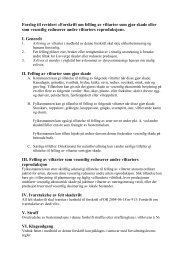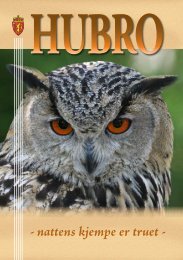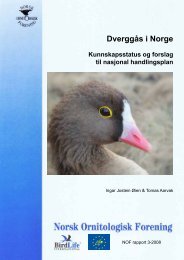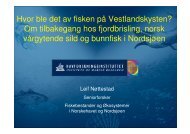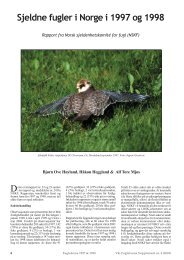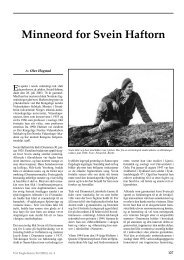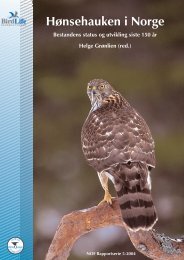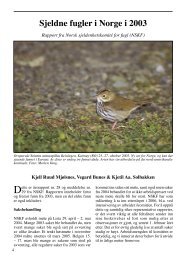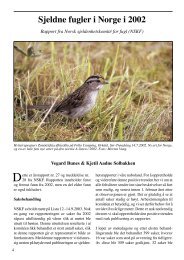Fennoscandian Lesser White-fronted Goose conservation project ...
Fennoscandian Lesser White-fronted Goose conservation project ...
Fennoscandian Lesser White-fronted Goose conservation project ...
You also want an ePaper? Increase the reach of your titles
YUMPU automatically turns print PDFs into web optimized ePapers that Google loves.
<strong>Fennoscandian</strong> <strong>Lesser</strong> <strong>White</strong>-<strong>fronted</strong> <strong>Goose</strong> <strong>conservation</strong> <strong>project</strong> – Annual report 1999<br />
Aarvak et al: Spring migration of <strong>Lesser</strong> <strong>White</strong>-<strong>fronted</strong> Geese in north–western Europe – an analysis from individual markings<br />
Spring migration of <strong>Lesser</strong> <strong>White</strong>-<strong>fronted</strong> Geese in north–western<br />
Europe – an analysis from individual markings<br />
32<br />
Tomas Aarvak 1 , Sami Timonen 2 , Ingar Jostein Øien 1 , Petteri Tolvanen 3 & Juha Markkola 4<br />
1 Norwegian Ornithological Society (NOF), Seminarplassen 5, N-7540 Klæbu, NORWAY,<br />
e-mails: tomas@birdlife.no, ingar@birdlife.no<br />
2 Kosteperänkatu 2 B 12 K, 90100 Oulu, FINLAND, e-mail: sami.timonen@vyh.fi<br />
3 WWF Finland, Lintulahdenkatu 10, FIN-00500 Helsinki, FINLAND, e-mail: tolvanen@sll.fi<br />
4 North Ostrobothnia Regional Environment Centre, P.O. Box 124, FIN-90101Oulu, FINLAND, e-mail: juha.markkola@vyh.fi<br />
1. Introduction<br />
In 1998, we were able to document that <strong>Lesser</strong> <strong>White</strong>-<strong>fronted</strong> Geese<br />
(Anser erythropus, later LWfG) utilising spring staging areas in<br />
Estonia, Finland and northern Norway were mainly the same<br />
individuals. This was achieved by comparing videotapes and belly<br />
patch drawings from the Valdak Marshes in spring 1998 with photos<br />
and belly patch drawings made during spring 1998 on the Bothnian<br />
Bay coast in Finland. Roughly calculated, 75% of the LWfG staging<br />
at the Bothnian Bay coast migrated further to the Valdak Marshes.<br />
This was also supported by the appearance of the same colour-ringed<br />
individual in both areas in spring 1998 (Aarvak et al. 1999). This<br />
individual was also observed in Haeska, Matsalu, W Estonia a few<br />
days prior to the observation in Finland (Aarvak et al. 1999). In<br />
1999 we extended the use of video equipment to follow individuals<br />
and pairs already from the staging area in Estonia to obtain a better<br />
understanding of the numbers and structure of the <strong>Fennoscandian</strong><br />
breeding population.<br />
2. Methods<br />
Øien et al. (1996) describe how the unique pattern of belly patches<br />
is used to follow the LWfG population staging at the Valdak Marshes.<br />
In Valdak all geese are drawn on ready-made sheets to provide a<br />
reliable estimate of the number of LWfG using the area. To create a<br />
more accurate archive of the individuals we have started to film the<br />
geese by video camera (Sony Handycam) mounted on a telescope<br />
(Swarovski AT 80 HD with 20-60 x zoom ocular) at the Valdak<br />
Marshes. This combination enables us to videotape the geese at much<br />
longer distances than would otherwise be possible with photographic<br />
equipment (cf. Aarvak et al. 1999). On the Bothnian Bay coast and<br />
in Estonia, a digital video camera (Canon MV10) mounted on a<br />
telescope (Leica Apo Televid with 20xW and 20-60 x zoom oculars)<br />
was used in the spring 1999. The main purpose was to improve the<br />
identification of individuals and pairs and ageing, and finally to reveal<br />
migratory movements and life history of individuals by comparing<br />
the belly patches on the videotapes from these three staging sites.<br />
Two examples of digital video images from the year 1999 (one from<br />
the Bothnian Bay coast, recorded in May; and one from Skjåholmen,<br />
Varangerfjord, recorded in August) are shown in this report, see pp.<br />
22 and 31.<br />
In Estonia, continuous monitoring was carried out from 23 April<br />
to 12 May (Tolvanen et al. 2000, pp. 18–21 in this report), on the<br />
Bothnian Bay coast in the period 5 May to 20 May (Timonen 2000,<br />
pp. 22–23 in this report) and at the Valdak Marshes in the period 13<br />
May – 6 June (Aarvak & Øien 2000, pp. 24–27 in this report).<br />
3. Results<br />
In total, 13 out of estimated 27 geese were filmed in the Bothnian<br />
Bay area. This excludes about half of the geese from the comparison.<br />
In Estonia most of the geese were filmed, but due to general low<br />
quality of the tapes, only eight pairs and two single males could be<br />
readily identified by their belly patch pattern. Out of the 43–51 LWfG<br />
seen in Estonia (Tolvanen et al. 2000, pp. 18–21 in this report), six<br />
pairs and two males arrived at Valdak. One of the males seemed to<br />
be unpaired in Estonia, but at Valdak he was paired with a female<br />
that was colour-ringed at the same site in 1997 (colour leg ring code:<br />
<strong>White</strong>-Black-Red). Whether this male later found a partner along<br />
the route or was paired already in Estonia is unknown. One of the<br />
pairs divorced at Valdak, but both individuals mated with other mates<br />
after two days at the Valdak Marshes. All the six pairs and two single<br />
male LWfG that were identified from the video tapes from both<br />
Estonia and Valdak, arrived at the Valdak Marshes during the<br />
relatively short time span between 19 and 23 May. At the Valdak<br />
Marshes, the first LWfG pair was seen 14 May, while the last pair<br />
arrived as late as 5 June (Aarvak & Øien 2000, pp. 24–27 in this<br />
report). At the Valdak Marshes, 21 pairs out of the estimated total of<br />
25 adult and subadult pairs were filmed. However, in practise all<br />
LWfG observed, excluding juveniles, were identified due to exact<br />
belly patch drawings.<br />
Only one of these pairs was also positively identified at<br />
Säärenperä on the Bothnian Bay coast. In addition to these birds,<br />
one more pair seen at the Bothnian Bay coast (Säärenperä) was also<br />
seen staging at the Valdak Marshes.<br />
Out of the pairs identified in the Matsalu area, two pairs were<br />
not seen at the Valdak Marshes. Similarly four pairs and one single<br />
bird of the LWfG identified in the Bothnian Bay area were not seen<br />
later at the Valdak marshes, showing that not all pairs migrate to the<br />
Valdak Marshes and further to the core breeding area in Norway.<br />
4. Discussion<br />
The videotapes and belly patch drawings collected from Estonia,<br />
Finland and Norway in 1999 confirmed the results from 1998, that<br />
the LWfG using these areas are mainly the same individuals.<br />
Unfortunately, in Finland it was not possible to obtain highquality<br />
videotape of the filmed individuals, and half of the observed<br />
geese could not be filmed at all because the LWfG mostly staged too<br />
far from the observers and in the mudflats at Säärenperä.<br />
In addition some methodological problems in Estonia made it<br />
impossible to gain reliable data on which birds migrate to the different<br />
staging sites in Fennoscandia. Only further work in the coming years<br />
will unveil this. At the Valdak Marshes it seems that the LWfG arrive<br />
via two different routes, because a bimodal distribution of LWfG<br />
numbers can be seen in some of the years where monitoring has<br />
been conducted at the Valdak marshes (see Aarvak & Øien 2000,<br />
pp. 24–27 in this report; Aarvak & Øien unpublished data). The lack<br />
of this bimodal distribution does, however, not preclude the existence<br />
of a population with mixed migratory behaviour. A more detailed<br />
analysis of the material and observations of colour ringed individuals<br />
are necessary.<br />
Since the LWfG positively identified in Estonia this spring arrived<br />
at the Valdak Marshes during a relatively short time period in May,<br />
we suggest that there might be two sub-groups of LWfG using the<br />
Valdak Marshes almost simultaneously. Results obtained by the use<br />
of satellite transmitters have shown that there are in fact two different<br />
migration routes during autumn (see Lorentsen et al. 1997), but<br />
whether these birds return along a common spring migration route<br />
is at present unknown.


